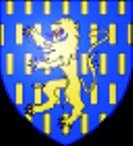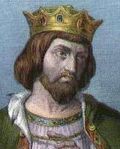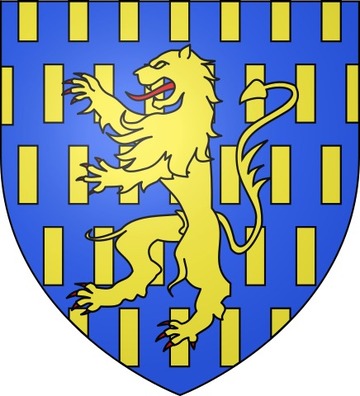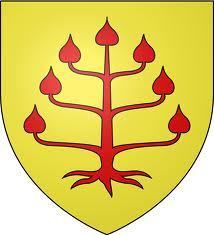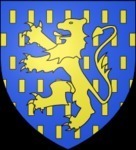maximum test » Robert 'le Bourguignon' de Nevers Seigneur de Craon & de Sablé (± 1026-1098)
Persoonlijke gegevens Robert 'le Bourguignon' de Nevers Seigneur de Craon & de Sablé
- Hij is geboren rond 1026 in Nevers, Nievre, Bourgogne, France.
- Hij is overleden in het jaar 1098Jerusalem
Israel. - Een kind van Renaud I de Nevers en Hedwige de France
- Deze gegevens zijn voor het laatst bijgewerkt op 19 januari 2019.
Gezin van Robert 'le Bourguignon' de Nevers Seigneur de Craon & de Sablé
Hij is getrouwd met Bertha "Blance" de Crequy.
Zij zijn getrouwd op 7 augustus 1057 te Nevers, Nievre, Bourgogne, France.
Kind(eren):
Notities over Robert 'le Bourguignon' de Nevers Seigneur de Craon & de Sablé
{geni:about_me} https://fr.wikipedia.org/wiki/Robert_de_Nevers
http://genealogics.org/getperson.php?personID=I00120903&tree=LEO
Wikipedia:Translated from French language if a smooth translation can be found please remove this. Janet Milburn 12/17:
Robert le Bourguignon became lord of Sablé by his alliance with the unique daughter of Geoffroy de Sablé . His older brothers were William , Count of Nevers , Henri and Gui . He was raised at the court of the Duke of Aquitaine and that of the Count of Anjou , by the care of his grand-aunt Agnès de Bourgogne , widow of William V of Aquitaine and second wife of Geoffroy Martel she married in 1032 .
Assisted by Geoffroy Martel, her second husband, Agnes had obtained for her two sons the paternal succession of Aquitaine and Poitou . She also protected Robert, his godson, trained him especially, and never son benefited better from his mother's lessons. When this adoptive mother was repudiated, after twenty years of union, her adopted son did not lose the confidence of Geoffroy Martel, whom he had served well and who appreciated his presence and his enlightened services.
First appearance
There is no Robert the Burgundian associated with the acts of Fulk Nerra , because from that time he was attached to the person of Geoffroy Martel, almost always at war with his father. There is however a title of the Ronceray , dated 1035 , in which appears Gui , " brother of Robert "; this quality given to an elder brother, seems to indicate that the notoriety of the younger brother was greater than his own. He was personally named for the first time in 1039 , on the occasion of the murder of a cousin of Geoffroy Martel. It is also probably the time of his alliance with the heiress of Sablé whose father, Geoffroy, does not reappear after the founding of Solesmes( 1010 ), and whose brothers were certainly dead too, because it is no longer mentioned, if not by mistake, in one of the confirmations of the founding of Solesmes, whose names can not be invoked, the names of the witnesses systematically scrambled. This rich alliance was due to the influence of Geoffroy Martel, and still more to that of the Countess Agnes, protector of the young nobleman, who would not have looked for the orphan if she had not been in possession of the inheritance.
Baron of Craon
The first important event in the Burgundian career, which doubled his fortune, was the gift of the barony of Craon , made in his favor by Geoffroy Martel.
Package
If one believed the founding act of the abbey of the Trinity of Vendôme of May 21, 1040 , this infeodation for Craon would have taken place even before that date, since it is there recounted, cum honorem Credonensem Roberto Burgundo donavimus says the founder. But it must be admitted that the charter is at least interpolated for this passage and for other articles
This date is contradicted by a very precise notice of the Cartulaire of the Abbey Saint Aubin d'Angers . The monks say that the first donation of St. Clement had been made by their Suhart I st Craon said Suhart Old, first lord of Craon , after 1007 , the date of the birth of Geoffrey Martel ; he complains that neither his father nor he had confirmed the donation. Coot Nerra , father of Geoffrey Martel , was still alive when Guerin Craon succeeded his father Suhart I st . Suhart II Guerin de Craon's brother, having replaced him, Saint-Aubin kept for a while the church of St. Clement under Geoffroy Martel. All this, it is stated with precision, required more than forty years, and this estimate of the monks of Saint-Aubin which would lead us after the year 1050 , agrees with March 26, 1053 , probable date of the abandonment of Craon to Robert le Bourguignon, and does not offer the contradictions of the Vendome charters. According to these, sometimes it is Suhart the old man, a tyrant punished by confiscation, who, on a just judgment of God, ended his life of impurity by a deserved death; sometimes it's Suhart II. We see again that the recovery of the church on Saint-Aubin is caused either by the lack of consent of the ecclesiastical and county authorities to the first cession, or by the fault of the Abbey Angevin who had not met the conditions imposed, or at last by the deceit of the Baron de Craon, guilty publicly acknowledged and who is stripped rightly.
What lies at the bottom of this accusation of forfeiture which would have motivated a confiscation on the lord of Craon by Geoffroy Martel ? A tradition which is not seen the original, but later charters and chronicles of the xiii th century , tells of a baron of Craon would have brought the homage of his domains Duke of Brittany in frustrating the Count of Anjou , his rightful overlord. The word forfeiture found in a text of the Cartulaire of the Abbey of Vendôme , may have given birth to the legend that Pierre Le Baud would have inserted in his History of Brittany , where she came from3 . Authors, even modernists, including Ménage , or Dom Morice in his Histoire de Bretagne , have admitted this dramatic narrative; Dom Piolin , D. de Bodard , the Abbé Charles Métais , editor of the Cartulaire de Vendôme , accepted the legend with all its details. A. Bertrand de Broussillon said he did not understand anything about forfeiture. Louis Halphen only concluded that everything was fiction in this story, including the ensuing war with Robert I st Vitre .
The Abbé Angot does not know how the first, author of the history of the House of Craon , saw nothing abnormal in the succession of the barons of the first house of Craon as he presents it to us: Guerin, eldest son Suhart I st , succeeding him, it is regular; but Suhart II, brother of Guerin, replacing its predecessor, while Guerin had left a girl named Bertha, married to Robert I stfrom Vitré, this is no longer possible. The inheritance of Craon was acquired with this one. How to explain this violation to the invariable rules of inheritance? It is true that Robert seems to have been, for a few years, deprived of the enjoyment of his own stronghold (at least one finds once a lord of Vitré named otherwise, perhaps by mistake). But Robert remarried after his first widowhood and had three children from this second marriage after 1090 . The eldest succeeded him. Finally, the fact is certain: Suhart the younger succeeded his brother, to the detriment of his niece.
For Abbot Angot, it is this irregular transmission that constitutes the act of felony, the cause of the confiscation of Craon by Geoffroy Martel ; and the confiscation, followed by the transfer of the barony to Robert the Burgundian, occasioned a war between Baron de Vitre , husband of the legitimate heiress of Craon, and the Duke of Brittany, against the Comte d'Anjou. If Suhart de Craon is mixed up in the legend, it can be an invention of chronicler, or a return of the baron to justice towards his niece. Louis Halphen did not see the difficulty, because he supposes Suhart the young son and not Guérin's brother, but he is certainly wrong ( County of Anjou , page 142 , No. 2, and table, at the word "").
The confiscation of the barony of Craon and that of the church of St. Clement are two related but separate issues. The barony, by a rule of feudal right, had returned to the suzerain after the violation of the hereditary right by Suhart the young, probably agreeing with Guérin, his brother, to the detriment of his niece. It is always thus that the charters speak of it: " Cum honor Credonis ab heredibus illius, which donationf fecerat, dominicus in manum suam (Gaufridi) per forfacta eorum futisset ", as it is read several times, the count thought it his duty to break the donation and attribute the church of St. Clement to the Trinity of Vendome by removing it at Saint-Aubin, and then concede, after March 26, 1053, the barony of Craon to Robert le Bourguignon.
This first act always retained its value. But the confiscation of the barony and the infeodation which was made to Robert the Burgundian, in spite of the multiple circumstances in which he had adorned himself with this title, were declared null and void, and when he married his eldest son to the daughter of Berthe, Enoguen de Vitre , legitimate heiress of the barony, this son, named Renaud, frankly declared that he only held the barony of Craon from his marriage and not from the paternal inheritance. It is true that we were then under the government of Geoffroy le Barbu and no longer under that of Geoffroy Martel. We must not look elsewhere for the explanation of the family convention under which Robert the Burgundian kept for him the seigniory of Sablé which came to him from the head of his wife and left to his son, husband of Enoguen de Vitré, the barony from Craon.
Géoffroy Martel
Robert the Burgundian bore the title of Baron of Craon until the marriage of his son. We see by the investiture that he had given Geoffroy Martel that the knight, long time lord of Sablé, no longer needed the protection of his aunt Agnès de Bourgogne, repudiated since 1052 , and that he enjoyed more than ever of the Count's favor. Around 1055 , Geoffroy Martel was partly campaigning ( deambulandi causa ) with his new wife on the island of Tirmont , accompanied by the first members of the clergy and great secular personages, and it is already Robert le Bourguignon who is at the head of all others, including the Baron de Chateau-Gontier , Alard I stfrom Château-Gontier . He has always been since. He had already attended the main foundations of Geoffroy Martel, 1040 to that of Vendome, in 1047 the erection of the chapter of Saint - Laud , and all the contemporary foundations of Anjou .
The first duty of the Lord of Sablé to the Count of Anjou was the service of arms. There is no doubt that he did so faithfully because of the confidence he enjoyed with Geoffroy Martel. He took part especially in the campaign of the Passais against William the Bastard . It was not successful because it led to the defeat of Geoffroy Martel in Ambrières ; but there is still glory to be beaten by such an adversary. Under Geoffroy le Barbu, nephew and successor to Geoffroy Martel, Robert had the same authority.
Geoffroy the Bearded
An expedition recommenced early in 1063 to go to Maine to help Gautier de Mantes against William the Bastard 4 Gautier, said Guillaume de Poitiers 5 , had called him several times, naming him his lord and protector. He even had difficulty with Marmoutier about the vassals of the abbey he wanted to summon when he was preparing this campaign " adversus Bigotos" ". The role of Robert the Burgundian does not allow to doubt that he took part in this expedition. It was also still a failure, as William the Bastard, who had taken possession of the Maine County due to him by the death without children of Count Herbert II of Maine 6 , took the Mans , then Mayenne , to revenge Geoffroy II de Mayenne , leader of the party Manceau. The war lasted no longer, and even William the Bastard wanted his son, Count of Maine, to pay homage to Geoffroy le Barbu, in front of him, in Alençon .
William the Conqueror
A charter of 1068 , concerning the priory of Brûlon , would make believe that Robert the Burgundian was faithful and faithful of the Conqueror; he was his vassal for Sablé, but this term can only be understood in this feudal sense; attached to the person of the Count of Anjou, it was something else, as we are going to see.
With him he appears in the act concerning the fortification of Saint-Florent , at the head of all the assistants, beside Renaud II of Chateau-Gontier who was to betray his master; but he was not with him in the number of those who delivered their master to his brother. Yet he had a part in the scene, lending his castle to serve as a prison. The new count made him keep from April 4 to July 16, 1067 , the day when Robert the Burgundian made on the church of Bouchamp a foundation for its first benefactor Geoffroy Martel. The August 7 following in Chaumont , including King Philip I stsieged with Geoffroy le Barbu and Foulque le Réchin , his brother, against Sulpice d'Amboise , who had perhaps offended the two brothers by not declaring themselves either for one or the other, Robert and Avoise, his wife, made another foundation that I would willingly believe a memory and an expiation of the captivity of the Count of Anjou. They endowed Marmoutier with the church of Saint-Malo and the other churches of Sablé, with the clause that the canons who served them would be replaced as and when they died by a monk. They completed their foundation of clearing the forest of Bouère , a place to make a village, a half of the customs, the church ofand six arpents of vines in Loudunois . This foundation later caused serious difficulties with the Couture .
Whatever Robert's feelings were for Geoffroy the Bearded , when Foulque le Rchin had quarreled with him again, defeated him, and imprisoned him for the end of his days, the lord of Sablé was placed under the orders of the conqueror. But it was no longer he who kept the captive, locked in the castle of Chinon , where no one was more interested in him until his death ( 1096 or 1099 ). Robert the Burgundian served the new count as faithfully and in the same honorable rank, with the primacy he had already had with Martel and Geoffroy le Barbu.
Foulque the Réchin having destroyed in his wars the convent of Saint-Florent, Robert, his brother Guy and Guy II of Laval attended the dedication of the new abbey, at the head of all the lords of the county ( March 11, 1068 ). In 1073 , a truce was concluded between Foulque le Réchin and William the Conqueror. The Gallia Christiana supposes that it was with Helie de la Fleche , but the author is mistaken. Besides, the event would in any case have the same meaning, for Jean de la Fleche , and not Helie de la Fleche, was the most powerful of the partisans of the King of England in Maine.
In 1076 took place the laborious settlement between the abbeys of the Couture and Marmoutier for their priories of Solesmesand Sablé. The affair showed the patience of Robert the Burgundian and the partiality for the Couture of the bishop Arnaud, partisan of William the Conqueror and enemy of Foulque the Réchin. Called to give his opinion, Robert, the most enlightened witness and the most interested in the question, made it in a speech whose monks have kept us two different editorial style, but similar in substance, beginning with a history of the city of Sablé: construction of the castle, the churches, replacement of the chapter of Saint-Malo by the priory of the same name, then establishment of Solesmes, its multiple pretensions of which the speaker recognizes only the right of burial of the bourgeois of the city. He ends by saying: Do the monks of the Couture have the right to claim these privileges? Dicat who intelligens.
The bishop made all the possible oppositions, asked the restoration of the canons - removed for misconduct, threatened, threw the ban on the town of Sablé. Advised by the Archbishop of Tours , Robert endured with respectful patience the trials of his bishop. In order to overcome Arnaud's opposition, it was necessary for his colleagues to declare to him that they would go overboard if he did not lift his prohibition himself. Robert le Bourguignon had not been able to go to Le Mans to follow the lawsuit because of his war, he said, but he went to Tours for the decision. This war was undoubtedly the state of continuous hostility where the Count of Anjou was against William the Conqueror, particularly the siege of Dolthat it was a matter of getting up, and the fight against Jean de la Fleche which had to be reduced.
The bravest Angevin knights were at Dol; it can not be done that Robert the Burgundian was one of the number, if he was in pursuit of Jean de la Fleche and the headquarters of the Arrow that Foulque gave up, having been wounded (September and October, and following months) ). The fight was barely interrupted, cut off from a truce in 1079 , resumed with the Bretons for associates in 1081 . La Fleche was taken then, and the peace concluded at Blanchelande , thanks to the intervention of Cardinal Hubert, agent of Hildebrand in Normandy , and monks who threw themselves between the Norman and Angevin armies. The struggle resumed again in 1083, led by Hubert II de Beaumont , lord also of Fresnay and Sainte-Suzanne , and the contest of Foulque le Réchin, because if he did not appear personally among the big ones of Maine, of Anjou, of Aquitaine , of Burgundy , he sent his principal representative, his adviser Robert le Bourguignon. They fought fiercely from the castle of Sainte-Suzanne to Baugi's camp , and, according to Orderic Vital , peace was made on Hubert's proposals to William the Conqueror ( 1083 - 1085 or beginning of 1086 ). Peace was honorable 7 .
Robert Courteheuse
Since then Robert remained in the feudal obedience of Robert Courteheuse , successor of William the Conqueror. In 1090 , he fought with the Duke of Normandy a mission Foulque Réchin who had promised to foil a new revolt of the manceaux, supporters of Hugh V of Maine , son of Azzon, returned from Italy , if the duke wanted him to procure the alliance of Bertrade de Montfort . The negotiation ended and Robert the Burgundian lent the duke the help of his weapons or his advice: " Robertus Burgundus cum Vetulus ad serviendum Roberto comiti perrexisset " ( 1090 - 1092 ).
Meanwhile, Hoel, bishop of Le Mans , struggling with Hugue V and confronting the intrigues of Canon Hilgot and his cabal, had sought to awaken Robert Courteheuse, then went to England to ask the help of William the Roux ; From there he returned to France , where he had sent to Sablé, where his partisans had taken refuge, to put under the care of Robert the Burgundian the treasure of the cathedral whose count threatened to seize, and had celebrated at Solesmes the feasts of Easter and Pentecost ( May 16, 1092 ). Reconciled finally with the count, he had returned to Le Mans ( July 27 ), while Hugue negotiated with Hélie de la Flèche a transaction that secured the county's enjoyment.
Crusade
Robert le Bourguignon, returned to Anjou as early as January 1092 , was back in Sablé on August 29th . Less than four years later, he was the subject of the most glorious distinction. Pope Urban II , who had just decreed the crusade in Clermont , arrived at Sablé on February 14 to solicit the help of the old lord, who was waiting for him in his walls and had deprived himself of being at the reception of Angers alongside Foulque le Réchin. He yielded to the prayer of the sovereign pontiff, took the cross, dragging with him the Baron of Château-Gontier, his son-in-law, and a crowd of knights. But he did not leave until 1098 because of the threats of the King of England, assignee of the rights of Robert Courteheuse, gone himself for Jerusalem , against Foulque the Réchin. The lord of Sablé then handed over his fief to his son Robert II and prepared himself Christianly for the expedition, renewed and increased his gifts to the abbeys, for him as those of Geoffroy Martel, Renaud and Robert, his sons, Berthe, his wife; Marmoutier, especially, was at the moment of departure the object of special favors. The Abbé Bernard had come to find him in Sablé: he gave him, among other things, the land of a new village, and made a donation to the prior on the 10th of March.. He then went to Marmoutier with a chaplain and Hardouin de Vion , his knight, who were to accompany him to the Holy Land . At Tours , he received an eager welcome and the promise of the votes of the monks; he confirmed, on his side, his former gifts, added others, and, as a signal for his passage, sent to Burgonde, his daughter, who had remained at Sablé, the gold ring which she had confided to him.
Since that day no one heard of him who had filled with the sound of his name, his benefactions, his works, the whole province. Moreover, he who left a flourishing family, a woman, friends, has his name to the obituary of any abbey. He has been called ubiquitous and is nowhere to be found the day he dies in the ranks of the Crusaders.
Possessions
The principal possessions of Robert le Bourguignon in Maine, where he was a foreigner, were Sablé, including the forest of Bouère, which advanced towards the city. The barony of Craon was granted to him around 1055 and he kept the title and the enjoyment perhaps until 1067 , since he was then suzerain of Bouchamp. He had domains in the Loudunois where was the church of Angliers. Brion belonged to him before 1060 , though Celestin Port attributes the gift to Foulque le Réchin. The lordship of Noyen , including Saint-Germain d'Amnéwas, according to Abbot Angot, the dowry of Berthe, his second wife, since we do not see the title at the end of his life, and that his wife and Alard II of Château-Gontier , his grandson, intervene in acts concerning this land. Durtal was attributed to him jointly with Marcouard de Daumeray by Foulque le Réchin, but it was only for a time, as guardian of Hubert de Champagne, who raised the name of Mathefelon .
Relations with the clergy
Robert the Burgundian had generous methods and friendly relations with the clergy and the monks. He claimed the abbeys of Marmoutier, Ronceray, Saint-Aubin, the Trinity of Vendome, Saint-Nicolas, Saint-Florent de Saumur, the suffrage of their prayers and filled them with benefits, recognized their privileges, their virtues He did not offend those who opposed him, often intervened with his friends to reconcile them with the monks.
He had officers and knights attached to his person, Ulric de Brûlon, his provost, Otherius, and Bouchard, his men, Ulric, who went to Jerusalem with him as well as Bartholomew and Hardouin de Vion, Coot of Walls.
Ordinary functions
His ordinary duties included, in addition to military service, the ministry of justice and the count's adviser's office. He was always the first of the witnesses since 1080 . The counts of Anjou did not have a seneschal at the time, but the burden would have been assured if it had existed. His depositions took on the appearance of oratorical plays, as we saw at Sablé ( 1076 ), and as we can still see when, when asked, he and Marcouart de Daumeray , about what they will do vis-à-vis monks at Durtal, not only does he declare that he will respect their rights, but, speaking for his partner, he dictates to him the conduct to be held in a tone of friendship and protection. " Sic me Deus adjuvet He said another time, beginning a favorable speech at Saint-Aubin. He freely distributes advice, advice, for example to his son to engage him to be less demanding of the monks of St. Vincent, or Renaud de Daumeray to prescribe a restitution to Marmoutier. His ministry is very varied: he and Renaud de Château-Gontier are the lay assistants of a plaid held by the bishop and the count between the Ronceray and Saint-Nicolas; he represents this last abbey in his claims to Brains ; as procurator of Count Foulque le Rchin, he pronounced for the benefit of Saint-Florent two sentences approved by the court; confirms an episcopal adjudication of the churches of Chantocéat Saint-Nicolas, and that of the legate Amat attributing to Montierneuf the church of Saint-Nicolas; himself pronounces a judgment for Saint-Nicolas d'Angers in 1092 ; Foulque le Réchin calls it unus ex meis optimatibus . He is referee in 1093 between Marmoutier and the canons of Chemillé; associated with Foulque le Réchin in a judgment in favor of Saint-Florent ( 1093 ). The presidency of the judiciary courts fell within its attributions, as we see in 1094in the company of Geoffroy de Mayenne, bishop of Angers, Marboeuf, Garnier and Foulque de Mathefelon. Holding his pleas in Saint-Maurice with ecclesiastical figures, he asked that the monks' witnesses be exempted from the oath out of respect for their clients ( 1096 ). He also respects his authority as in 1090 , citing before him, Sablé, the abbot of Saint Vincent, who goes to the summons with the bishop of Mans Hoel. The judge gives him besides the church of Saint-Germain, object of a litigation.
With the counts he served under three reigns, and under difficult circumstances, he is constantly in favor. We do not see any differences with his neighbors, who know his justice and firmness.
Family
Avoie de Sablé, or Blanche, first wife of Robert the Burgundian, dies between 1067 to 1070 . She had given him three sons and one daughter at least:
Renaud ,
Geoffroy 8 ,
Robert , the only son mentioned with his elder Renaud, except in one or two of his father's oldest charters, was the author of the Sablé branch.
Burgundy 9 .
The abbot Angot ignores a fourth son, named Henry, said Henri de Nevers attributed to him after Gilles Ménage 10 . Henri de Nevers had a son, Geoffrey of Vendôme , the future bishop of Vendome 11 .
Robert le Bourguignon married a second wife named Berthe. A. Bertrand Broussillon had advanced in his genealogy she was the daughter of Guerin Craon , widow of Robert I st Vitre 12 . But he reformed this opinion in the House of Laval 13 , recognizing that Berthe, wife of Robert de Vitré, had died before her husband, and could not be wife of Robert le Bourguignon, remarried twenty years before the death of Robert de Vitré . Robert's second wife was also named Berthe, an unknown family, they say. We may have been too quick to give him this qualification. It is certain that among the domains of Robert, he is one, inNoyen , including at least the parish of St. Germain and the suzerainty of Amné , which became his possession only towards the end of his life. The lord of Sablé, who had already obtained this land equal to the great baronies and was also owed to the generosity of Geoffroy Martel the barony of Craon, would still have found the opportunity, through his second alliance, to increase his fortune by one. seigniory of Upper Maine , which passed into the inheritance of his younger son, Robert.
Berthe did not give birth to her husband, but she is often quoted with him, described as " venerable lady, " wife of Robert the Burgundian. A. Bertrand de Broussillon expresses the idea that Geoffroy de Brion's charter of 1108, where he is given this title, is falsely dated, since Berthe had been a widow for ten years. It is not so. The charter was signed between Maze and the Chaussée de Maze, where the Counts of Anjou, Foulque le Rchin, and Foulque, his son, had met with Helie, Count of Maine. There is no doubt that the object of the conference was the marriage of the future Count of Anjou with Ermengarde, daughter of Helie de la Flèche, which took place shortly before the death of Foulque le Réchin, father of the young man, the April 14, 1109 .comes from the fact that the death of Robert the Burgundian, left for the crusade, was not yet known. His chaplain Bartholomew, his knight, did not return more than their lord; his son Robert, who left two years later, also died in the Holy Land . Finally, the first statement of their disappearance is a charter of 1110 where Lisiard, grandson of Robert the Burgundian, is said seigneur of Sablé. Renaud III of Château-Gontier also died in the holy countryside, but he at least had a mention of his glorious death before 1102 . Renaud, Robert's eldest son, remained in his barony, but died at that time (December 1101 ).
Robert the Burgundian was a remarkable man, the main character of Sablé's family, says Ménage. Benevolent, never seeking quarrel, happy all his life, clever, he rose in his midst at the most honorable post, having above him only his master the Count of Anjou. If he had lived, like his great-grandson by marriage, William des Roches , carried by fortune to the court of kings, he would have risen like him. Both were worthy of each other.
Tijdbalk Robert 'le Bourguignon' de Nevers Seigneur de Craon & de Sablé
Deze functionaliteit is alleen beschikbaar voor browsers met Javascript ondersteuning.
Klik op de namen voor meer informatie.
Gebruikte symbolen:  grootouders
grootouders
 ouders
ouders
 broers/zussen
broers/zussen
 kinderen
kinderen
 grootouders
grootouders
 ouders
ouders
 broers/zussen
broers/zussen
 kinderen
kinderen
Voorouders (en nakomelingen) van Robert 'le Bourguignon' de Nevers
Robert 'le Bourguignon' de Nevers 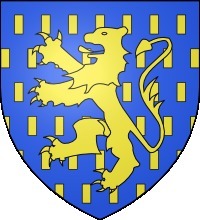 | ||||||||||||||||||||||||||||||||||
1057 | ||||||||||||||||||||||||||||||||||
Bertha "Blance" de Crequy | ||||||||||||||||||||||||||||||||||
De getoonde gegevens hebben geen bronnen.
Aanknopingspunten in andere publicaties
Deze persoon komt ook voor in de publicatie:Over de familienaam De Nevers
- Bekijk de informatie die Genealogie Online heeft over de familienaam De Nevers.
- Bekijk de informatie die Open Archieven heeft over De Nevers.
- Bekijk in het Wie (onder)zoekt wie? register wie de familienaam De Nevers (onder)zoekt.
De publicatie maximum test is opgesteld door Ard van Bergen.
Wilt u bij het overnemen van gegevens uit deze stamboom alstublieft een verwijzing naar de herkomst opnemen:
Ard van Bergen, "maximum test", database, Genealogie Online (https://www.genealogieonline.nl/maximum-test/I6000000006929968676.php : benaderd 9 mei 2024), "Robert 'le Bourguignon' de Nevers Seigneur de Craon & de Sablé (± 1026-1098)".
Ard van Bergen, "maximum test", database, Genealogie Online (https://www.genealogieonline.nl/maximum-test/I6000000006929968676.php : benaderd 9 mei 2024), "Robert 'le Bourguignon' de Nevers Seigneur de Craon & de Sablé (± 1026-1098)".
